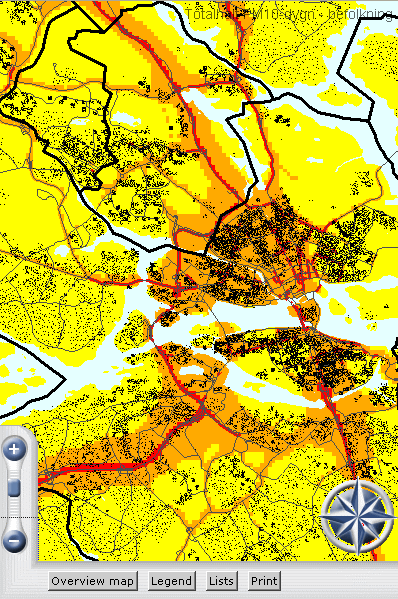Dålig luft i innerstan
Ett mått på luftkvalitet som man inte känt till så länge är halten av partiklar under 10 mikrometer i storlek, s k PM10. När man började mäta det så gick Stockholm från att ha uppfattats vara en av Europas renaste huvudstäder vad gäller luft, till att bli en av de smutsigaste. Dubbdäck mot asfalt är orsaken. Ja, och bristen på ringleder för trafiken.


På Stockholms och Uppsala läns luftvårdsförbunds sajt webbsajt kan man läsa mer och zooma in olika områden av Storstockholm. Bilden ovan är från deras sajt.
Wikpedia kriver följande om små partiklar:
(min fetstil)The effects of inhaling particulate matter has been widely studied in humans and animals and include asthma, lung cancer, cardiovascular issues, and premature death.
The size of the particle is a main determinant of where in the respiratory tract the particle will come to rest when inhaled. Larger particles are generally filtered in the nose and throat and do not cause problems, but particulate matter smaller than about 10 micrometres, referred to as PM10, can settle in the bronchi and lungs and cause health problems. The 10 micrometer size does not represent a strict boundary between respirable and non-respirable particles, but has been agreed upon for monitoring of airborne particulate matter by most regulatory agencies.
Similarly, particles smaller than 2.5 micrometres, PM2.5, tend to penetrate into the gas-exchange regions of the lung, and very small particles (< 100 nanometers) may pass through the lungs to affect other organs. In particular, a study published in the Journal of the American Medical Association (Pope et. al, 2002), indicates that PM2.5 leads to high plaque deposits in arteries, causing vascular inflammation and atherosclerosis — a hardening of the arteries that reduces elasticity, which can lead to heart attacks and other cardiovascular problems. Researchers suggest that even short-term exposure at elevated concentrations could significantly contribute to heart disease.
There is also evidence that particles smaller than 100 nanometres can pass through cell membranes. For example, particles may migrate into the brain.
It has been suggested that particulate matter can cause similar brain damage as that found in Alzheimer patients. Particles emitted from modern diesel engines (commonly referred to as Diesel Particulate Matter, or DPM) are typically in the size range of 100 nanometres (0.1 micrometres). In addition, these sootcarcinogenic components like benzopyrenes adsorbed on their surface.
Se även artiklar i Svd och DN. DN har också en bra karta.